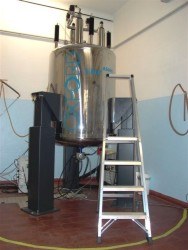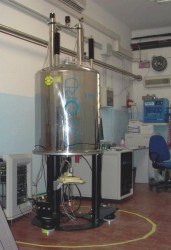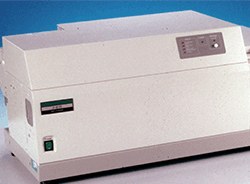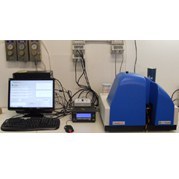Organic Spectroscopy
The Organic Spectroscopy group (Navile - UE4 – Fourth Floor – Laboratory 11) performs fundamental research on the conformational analysis of organic molecules.
The conformational processes of organic molecules can be observed by Dynamic Nuclear Magnetic Resonance (D-NMR), and modelled by DFT calculations.
When the rotational barriers are very high and atropisomers are generated, they can be resolved using chiral HPLC columns. The development of novel compounds with axial chirality has become an interesting research field for the development of enantiopure molecules and drugs lacking canonical stereogenic carbons. Atropisomers due to C-C, C-N and C-B bonds have been studied.
Determination of relative configuration is done by means of NMR spectroscopy: 1H-NMR, 13C-NMR, NOESY and bidimensional experiments.
DFT and TD-DFT calculations associated with chiro-optical methods (ECD and VCD) can provide the absolute configuration of organic molecules when the X-Ray anomalous dispersion method is not applicable. DFT and TD-DFT calculations can also be used to predict fluorescence of organic molecules.
Thesis positions available:
1) Synthesis of novel atropisomers with boro-nitrogen bond
2) Synthesis of novel atropisomeric drugs
3) Computational calculations
Instruments

Varian Unity-INOVA 600 MHz
Located in the "NMR laboratory", is actually the most powerful NMR in Bologna. It is equipped with a triple-resonance PFG indirect probe, a SW-PFG Probe and an expecially designed VT probe (-180 to +180 °C)

Varian Mercury-Plus 400 MHz
Located in the "NMR laboratory", it is used for advanced routine spectra. It is equipped with a broadband PFG probe, a dual-band indirect probe, and an expecially designed VT probe.

Electronic Circular Dichroism ECD - Jasco J-810
With this type of technique the enantiomeric excess and the absolute configuration of organic molecules can be determined if the spectrum of the corresponding enantiopure substance is known.
Electronic Circular Dichroism (ECD) uses circularly polarized radiation which is absorbed differently by the two optical antipodes.
The main advantage of this technique is that it can analyze molecules that have absorption in the ultraviolet region.
ECD technique coupled with quantum mechanical calculation (TD-DFT and EOM-CCSD) can reliably determine the absolute configuration of a new organic substance without resorting to the clssical anomalous dispersion X-ray diffraction technique.

Vibrational Circular Dichroism VCD
With this type of technique the enantiomeric excess and the absolute configuration of organic molecules can be determined if the spectrum of the corresponding enantiopure substance is known.
The VCD (Vibrational Circular Dichroism) technique has recently established itself in the field of analysis of optically active compounds.
Like the best known technique of Electronic Circular Dichroism (ECD) it uses circularly polarized radiation which is absorbed differently by the two optical antipodes.
The difference with the ECD technique lies in the type of polarized radiation which is infrared.
The main advantage of this technique is that it can analyze molecules that do not have absorption in the ultraviolet region.
The VCD technique associated with quantum mechanical calculation can directly and reliably determine the absolute configuration of a new organic substance without resorting to the more known anomalous X-ray diffraction technique.
The VCD dichrograph available to the Center was installed in spring 2011 and is equipped with a 37 KHz ZnSe photoelastic modulator and a dual IR optical bench with MCT detector for better sensitivity.
It is possible to record spectra at variable temperatures.
It is also possible to record solid film spectra thanks to the rotation of the IR cell during acquisition.
HPLC Waters 600 with 2487 UV detector and high-flow pumps
Columns
Reverse Phase:
Analytic:
1) Kromasil KR100-5-C18 250x4.60 mm
2) Luna 5u PFP(2) 100 A 250x4.60 mm
3) Gemini-NX 3u C18 110 A 150x4.60 mm
4) Gemini-NX 5u C18 110 A 150x4.60 mm
Semipreparative:
1) Luna 5u C18(2) 100 A 250x10.00 mm
2) Luna 5u C8(2) 100 A 250x10.00 mm
3) Luna 5u HILIC 200 A 250x10.00 mm
4) Kromasil KR100-5-C18 250x10.00 mm
5) Synergi 4u Hydro-RP 80 A 250x10.00 mm
6) Synergi 4u Polar-RP 80 A 250x10.00 mm
7) Synergi 4u MAX-RP 80 A 250x10.00 mm
8) IB N-5 5u 250x10.00 mm
9) Lux 5u i-Amylose-1 250x10.00 mm
Preparative:
1) Luna 10u C18(2) 100 A 250x21.20 mm
2) Luna 5u HILIC 200 A 250x21.20 mm AXIA Packed
3) Synergi 4u Polar-RP 80 A 250x21.20 mm
CSP-Reverse Phase:
Analytic:
1) Chiralpak AD 250x4.60 mm
Direct Phase:
Semipreparative:
1) Nova-Pak® Silica 6u 300x7.8 mm
Preparative:
1) Nova-Pak® Silica 6u 300x19 mm
CSP-Direct Phase:
Semipreparative:
1) Lux 5u Cellulose-2 250x10.00 mm
2) Lux 5u Amylose-2 250x10.00 mm
Preparative:
1) ChiralPak AD-H 250x21.20 mm
Servers:
- Dell Poweredge 1600, 8 Xeon processors, 24 gb RAM ("Neo")
- HP Proliant, 16 Xeon Processors, 32 gbyte RAM ("Trinity")
- Sun Fire X4450, 16 Xeon Processors, 32 Gbyte RAM ("x4450")
- Acer 585 server, 64 Opteron 6376 processors, 64 Gbyte RAM ("acer585")
- HP Proliant DL580G9, 88 Xeon E7-8880v4 processors, 256 Gbyte RAM ("HP580")
Contacts
Prof. Andrea Mazzanti
Prof. of Organic Chemistry
Teaching: 66173 - CHIMICA ORGANICA CON LABORATORIO M (Modulo 2)
06944 - COMPLEMENTI DI CHIMICA ORGANICA - 4 cfu
79092 - SPECTROMETRIC IDENTIFICATION OF ORGANIC COMPOUNDS WITH LABORATORY - 4 cfu
Dipartimento di Chimica Industriale "Toso Montanari", Via Gobetti 85, 40129, Bologna-Italy
+39 051 20 9 3632
Prof. Michele Mancinelli
Prof. di Chimica Organica
Teaching:
66683 - CHIMICA ORGANICA I CON LABORATORIO - 10 cfu
06944 - COMPLEMENTI DI CHIMICA ORGANICA - 4 cfu
67062 - CHIMICA ORGANICA CON LABORATORIO (Modulo 3)
Dipartimento di Chimica Industriale "Toso Montanari", Via Gobetti 85, 40129, Bologna
+39 051 20 9 3645